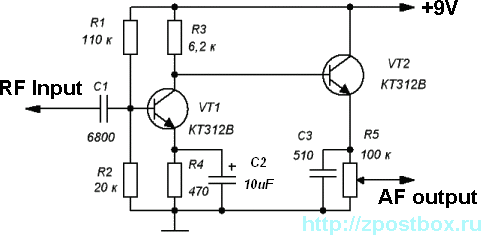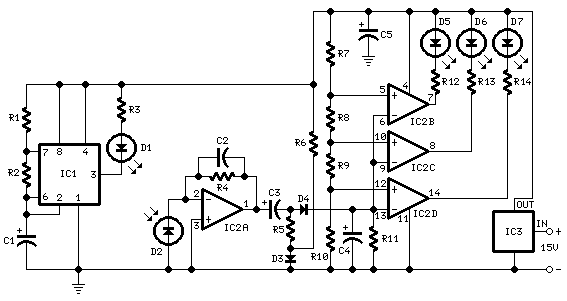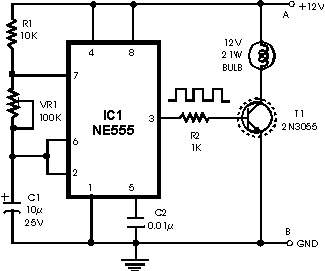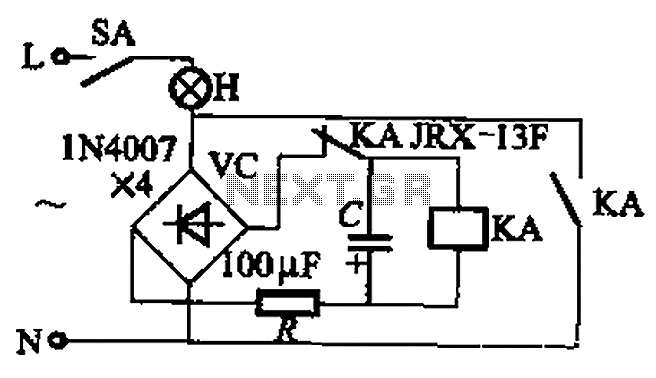
light sensor circuit
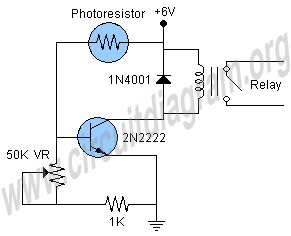
This is a light sensor circuit designed to detect light and activate a relay. The circuit is straightforward and requires only a few components. The operation of the circuit is simple: when the photoresistor detects light, it will turn on the 2N2222 transistor. Once the transistor is activated, it will engage the relay switch, thereby powering any equipment connected to the relay. A 5-6 volt relay should be used. The sensitivity of the circuit can be adjusted using a 50K variable resistor.
The light sensor circuit operates based on the principle of light detection through a photoresistor, also known as a light-dependent resistor (LDR). The photoresistor is a variable resistor whose resistance decreases with increasing incident light intensity. This change in resistance is crucial for triggering the transistor.
In the circuit, the photoresistor is connected in a voltage divider configuration with the 50K variable resistor. When light falls on the photoresistor, its resistance drops, causing the voltage at the base of the 2N2222 transistor to rise. The 2N2222 is a general-purpose NPN transistor that, when activated, allows current to flow from the collector to the emitter. This current flow is sufficient to energize the relay coil.
The relay serves as a switch that can control larger loads, such as lights or other electrical devices. A relay rated for 5-6 volts is recommended to ensure compatibility with the circuit's voltage levels. The relay contacts can be configured to either normally open (NO) or normally closed (NC) depending on the desired operation of the connected equipment.
The sensitivity of the light detection can be fine-tuned using the 50K variable resistor. By adjusting this resistor, the threshold at which the photoresistor will activate the transistor can be altered, allowing for greater flexibility in various lighting conditions.
It is essential to ensure that the circuit is powered by an appropriate voltage source that matches the relay's requirements, and that all components are rated for the expected load to prevent damage. Proper heat dissipation for the transistor may also be necessary, depending on the load connected to the relay. Overall, this light sensor circuit is a practical solution for automated lighting systems and other applications requiring light detection and control.This is a light sensor circuit which will detect light and switch on the relay. This light switch circuit is very simple and using only few components. Working of the circuit is simple, when the photoresistor receives light it will switch on the transistor 2N2222, when transistor become ON it will activate the relay switch and any equipment connec ted with the relay will become activated. Use 5-6 volt relay. The sensitivity of the circuit can be adjusted with 50K variable resistor. 🔗 External reference
The light sensor circuit operates based on the principle of light detection through a photoresistor, also known as a light-dependent resistor (LDR). The photoresistor is a variable resistor whose resistance decreases with increasing incident light intensity. This change in resistance is crucial for triggering the transistor.
In the circuit, the photoresistor is connected in a voltage divider configuration with the 50K variable resistor. When light falls on the photoresistor, its resistance drops, causing the voltage at the base of the 2N2222 transistor to rise. The 2N2222 is a general-purpose NPN transistor that, when activated, allows current to flow from the collector to the emitter. This current flow is sufficient to energize the relay coil.
The relay serves as a switch that can control larger loads, such as lights or other electrical devices. A relay rated for 5-6 volts is recommended to ensure compatibility with the circuit's voltage levels. The relay contacts can be configured to either normally open (NO) or normally closed (NC) depending on the desired operation of the connected equipment.
The sensitivity of the light detection can be fine-tuned using the 50K variable resistor. By adjusting this resistor, the threshold at which the photoresistor will activate the transistor can be altered, allowing for greater flexibility in various lighting conditions.
It is essential to ensure that the circuit is powered by an appropriate voltage source that matches the relay's requirements, and that all components are rated for the expected load to prevent damage. Proper heat dissipation for the transistor may also be necessary, depending on the load connected to the relay. Overall, this light sensor circuit is a practical solution for automated lighting systems and other applications requiring light detection and control.This is a light sensor circuit which will detect light and switch on the relay. This light switch circuit is very simple and using only few components. Working of the circuit is simple, when the photoresistor receives light it will switch on the transistor 2N2222, when transistor become ON it will activate the relay switch and any equipment connec ted with the relay will become activated. Use 5-6 volt relay. The sensitivity of the circuit can be adjusted with 50K variable resistor. 🔗 External reference
Warning: include(partials/cookie-banner.php): Failed to open stream: Permission denied in /var/www/html/nextgr/view-circuit.php on line 713
Warning: include(): Failed opening 'partials/cookie-banner.php' for inclusion (include_path='.:/usr/share/php') in /var/www/html/nextgr/view-circuit.php on line 713
